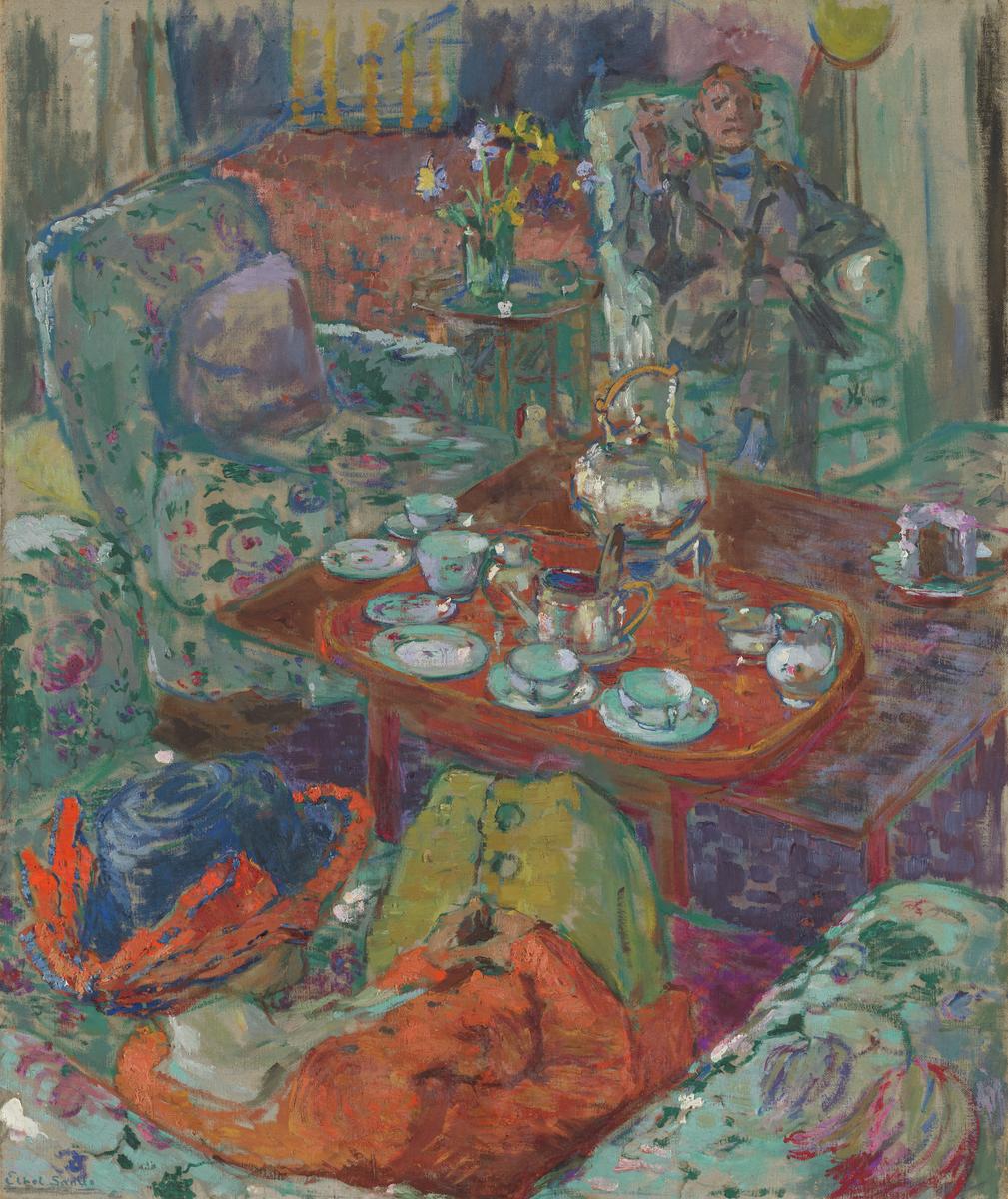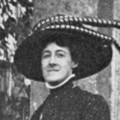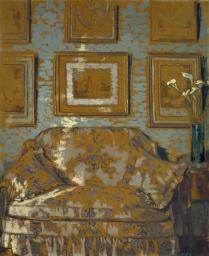Ethel Sands Tea with Sickert c.1911-12
© The estate of Ethel Sands
Ethel Sands,
Tea with Sickert
c.1911-12
© The estate of Ethel Sands
The table in the sitting room of Ethel Sands’s residence at 42 Lowndes Street in Kensington is set for afternoon tea for three. Walter Sickert, enclosed by chintz-covered furnishings, poses confidently in the background with cigar in hand. Seen from a high angle in the foreground, Nan Hudson, wearing a large hat, sits in the crook of the sofa with the viewer looking down onto the large buttons of her yellow skirt. The composition reveals the dynamic of Sickert’s relationship with Sands and Hudson; the two women admired the elder painter without allowing him to dominate their personal artistic vision.
Ethel Sands 1873–1962
Tea with Sickert
c.1911–12
Oil paint on canvas
635 x 507 mm
Inscribed by the artist ‘Ethel Sands’ in blue paint bottom left
Bequeathed by Colonel Christopher Sands 2000, accessioned 2001
T07808
c.1911–12
Oil paint on canvas
635 x 507 mm
Inscribed by the artist ‘Ethel Sands’ in blue paint bottom left
Bequeathed by Colonel Christopher Sands 2000, accessioned 2001
T07808
Ownership history
By descent from the artist to her nephew Christopher Sands 1962, by whom bequeathed to Tate 2000.
Exhibition history
1912
Paintings by Ethel Sands and A.H. Hudson, Carfax Gallery, London, June 1912 (37, as ‘A Tea-Table’).
1976
Camden Town Recalled, Fine Art Society, London, October–November 1976, Graves Art Gallery, Sheffield, November–December 1976 (123, as ‘Tea with Walter Richard Sickert’).
1977
Miss Ethel Sands and her Circle, Fine Art Society, London, April–May 1977 (4, as ‘Tea with Walter Richard Sickert’).
1988
The Painters of Camden Town 1905–1920, Christie’s, London, January 1988 (113, reproduced).
References
1977
Wendy Baron, Miss Ethel Sands and her Circle, London 1977, pp.93, 95–6, reproduced between pp.220–1.
2004
Alicia Foster, Tate Women Artists, London 2004, p.161.
2006
Valerie Webb, The Camden Town Group: Representations of Class and Gender in Paintings of London Interiors, Guildford 2006, pp.83–4, reproduced fig.28.
Technique and condition
Tea with Sickert is painted on a commercially primed, fine-linen canvas supplied by the artists’ colourmen L. Cornelissen. The canvas was supplied stretched and prepared with size and a thin off-white primer, which is probably oil-based. [t] Sands initially marked out the outline of the composition in a diluted oil paint applied with a fine brush. She used a brown-coloured paint to outline the figure of the woman, her clothing and the furniture and a blue/green-coloured paint to mark out the furniture. Working within the outlines, she laid in a very thin, dilute paint with rapid, broken brushstrokes, leaving the ground visible between strokes as a base colour. This initial stage of painting is still visible in the more sketchy areas of the upper half, such as the figure of Sickert and his chair. After the lean blocks of colour were laid in, detail was added with thicker, more medium-rich paint, using a loaded square-tipped brush and forming impasto peaks. These colours were often applied either in parallel brushstrokes denoting straight lines, such as the table at the centre, or descriptive rounded strokes denoting curves, such as the hat in the foreground. Finally, the white highlights were added and the painting was left unvarnished.
Annette King
November 2004
How to cite
Annette King, 'Technique and Condition', November 2004, in Nicola Moorby, ‘Tea with Sickert c.1911–12 by Ethel Sands’, catalogue entry, August 2003, in Helena Bonett, Ysanne Holt, Jennifer Mundy (eds.), The Camden Town Group in Context, Tate Research Publication, May 2012, https://wwwEntry
The friendship between Walter Richard Sickert and the American painters Ethel Sands and Nan Hudson lasted for over twenty years and led to the two women’s inclusion in the Fitzroy Street Group and subsequently the London Group. Sickert had first met the two in 1906 at a restaurant in Paris, later recalling to Hudson that ‘it was refreshing to find someone spiritually & intellectually on the slightly higher level for which I have always had a sneaking snobbish & perhaps pedantic hankering ... Ethel was silent but I concluded she was probably amazing & took her on trust into my immediate affections as well.’1 He renewed his acquaintance with Hudson the following year after greatly admiring one of her paintings exhibited at the Salon d’Automne in Paris, and he shortly afterwards invited both Hudson and Sands to join his Saturday ‘At Homes’ in Fitzroy Street. The trio developed a genuine and long-lasting friendship which proved to be of benefit to all parties.
This friendship is recorded in Sands’s picture, Tea with Sickert, painted in about 1911–12, during the active period of the Camden Town Group. The painting shows a comfortable sitting room furnished with two chintz-covered armchairs and a sofa, arranged around a low table set for afternoon tea. The interior is almost certainly 42 Lowndes Street in Kensington, Sands’s London address between 1906 and 1913. Sickert is the suited man sitting cross-legged in one of the armchairs and smoking, and the woman seated on the sofa with her back to the viewer and her face obscured is probably Hudson. The style of dress fits in with her preference for tailored clothes and large flamboyant hats. The central armchair is empty, implying the absence of the artist.
The institution of afternoon tea is a peculiarly British tradition combining refreshment with an emphasis on refined formal ritual and social interaction. It is commonly regarded as a feminine preserve and a woman would be expected to preside over the pouring of tea and the serving of food. The Saturday afternoon ‘At Homes’ of the Fitzroy Street Group, where members exhibited and viewed works, were arranged around the precept of afternoon tea. Sickert coupled his invitation to Sands and Hudson to participate in the proceedings with an expectation that they would undertake to serve the tea. He wrote to Hudson, not entirely tongue-in-cheek, ‘Of course you understand that henceforth you are hostess in Fitzroy Street & I hope you will “behave as such”’.2 The tea table in Sands’s painting is laid with fine bone china cups and saucers and plates for three people. A silverware kettle containing hot water rests upon a stand next to a teapot with the lid open, waiting for the tea to be made. Also on the tray are a china sugar bowl and a milk jug, a silver tea caddy and what is probably a tea strainer or a bowl containing slices of lemon. A partially cut iced fruitcake stands to one side to accompany the tea.
The art historian Wendy Baron has commented that Sickert was ‘almost pathologically incapable of withholding his advice and criticism from any painter in whom he spotted potential’,3 and much of his correspondence to Sands and Hudson, now in Tate Archive, is punctuated with instructions on how to alter their technique and improve their work according to Sickert’s own methods and beliefs. Hudson and Sands both greatly admired Sickert and his painting and undoubtedly benefited from their absorption into the Fitzroy Street circle. They were, however, both extremely independent and single-minded and, unlike some of Sickert’s pupils, never lost their own stylistic identities. Their friendship with Sickert relied upon their good-humoured acceptance of his criticisms and implied superiority, and they played out the role of disciples to the master, while not allowing the force of Sickert’s arguments to swamp their own individualities. Sickert wrote to Hudson in 1913, ‘The duplicity of the sex! You shut your dear button hole of a mouth, & Ethel opens hers with a becoming smile & looks at me straight in the face with eyes of melting tenderness, & all the while you are both nursing the bleakest of sentiment on account of the injury to your spurned canvases!’4
Tea with Sickert is a reflection of the unique nature of the relationship between Sickert, Hudson and Sands. Sickert’s relaxed, somewhat affected pose, cross-legged with one hand on his hip and the other holding a cigarette or cigar, is one of complete ease, familiarity and self-confidence. He is totally comfortable in his surroundings and he is the unquestioned focus of the artist’s and the viewer’s gaze. His positioning in the top right-hand corner of the painting at the back of the interior and the sketchy, insubstantial painted treatment of his figure means, however, that he does not dominate the scene completely. Equal aesthetic treatment is given to the entire surface of the painting so that the figure of Sickert is only one element of the pictorial whole. When the painting was first exhibited in 1912 it was simply titled A Tea-Table. Sickert’s place within Sands’s own domestic environment is carefully managed by her as the artist. He is defined in relation to the carefully spaced, feminine furniture, and the larger figure of Hudson is placed diagonally opposite him so that he is assimilated into the scene and appears to be part of her world, rather than she aspiring to be part of his. The painting is simultaneously a record of a cherished and pleasurable friendship and a statement of independence from Sickert’s overwhelming personality. The art historian Alicia Foster has argued that the title was changed to Tea with Sickert in order to capitalise on Sickert’s name and make the painting more marketable for sale.5
Despite Sickert’s admiration for Hudson and Sands, his invitation to them to join the Fitzroy Street Group was not extended to membership of the rather more formalised and professional Camden Town Group. According to Charles Ginner, both Sickert and Gilman agreed that women should be excluded from joining, largely to avoid the inclusion of wives and ‘lady friends’ who might lower the artistic standards of the group.6 Sickert made no apologies to the women for their non-inclusion, writing to Hudson, ‘As a matter of fact, as you probably know, the Camden Town Group is a male club, & women are not eligible. There are lots of two sex clubs, & several one sex clubs, & this is one of them.’7 Unfortunately, there is no record of Hudson’s and Sands’s thoughts about the ban on women but they were not deterred from involvement with the London artistic avant-garde. In June 1912 they held a joint exhibition of their work at the commercial platform of the Camden Town Group, the Carfax Gallery. Among the paintings exhibited by Sands was Tea with Sickert, which the Westminster Gazette called ‘a daring picture’ but ‘a somewhat overwhelming indulgence in pure orange vermilion’.8 Roger Fry dismissed the whole show as ‘frankly feminine’.9

Edouard Vuillard 1868–1940
Girl in an Interior circa 1910
Oil on board
support: 725 x 645 x 5 mm; frame: 870 x 790 x 45 mm
Tate N04436
Presented by the Contemporary Art Society 1929
Fig.1
Edouard Vuillard
Girl in an Interior circa 1910
Tate N04436
Although not included in either of Roger Fry’s post-impressionist exhibitions, Vuillard’s work was relatively well known in London during this period through his regular contact with British collectors, artists and exhibiting organisations and was rated highly among the London avant-grade.12 The art historian Belinda Thomson has highlighted the close affinity between the art of Vuillard and Sickert, who praised Vuillard in his 1910 exhibition review of the International Society of Sculptors, Painters and Gravers for the delicate and powerful effect of his ‘scrawled splashes of distemper’.13 Sickert seems to have admired the effects Vuillard achieved in his paintings, almost in spite of himself. The French artist’s notational technique and interest in decorative pattern and colour was completely antithetical to Sickert’s own methods and aesthetic beliefs, yet he admitted that despite being ‘shocked at the violence of the means ... an added stroke would be tautology and a detraction’.14 In his instruction of Sands, Sickert continually tried to get her to abandon her own methods of directly painting in front of the subject, in favour of working from sketches. Although she experimented with this practice, she never really took to it and despite featuring the man himself, Tea with Sickert reveals more of Sands’s artistic debt to Vuillard than to Sickert.
Nicola Moorby
August 2003
Notes
Reproduced in Elizabeth Wynne Easton, The Intimate Interiors of Edouard Vuillard, exhibition catalogue, Museum of Fine Arts, Houston 1989 (41).
Related biographies
Related essays
Related catalogue entries
Related reviews and articles
- Charles Ginner, ‘The Camden Town Group’ The Studio, November 1945, pp.129–36.
How to cite
Nicola Moorby, ‘Tea with Sickert c.1911–12 by Ethel Sands’, catalogue entry, August 2003, in Helena Bonett, Ysanne Holt, Jennifer Mundy (eds.), The Camden Town Group in Context, Tate Research Publication, May 2012, https://www





